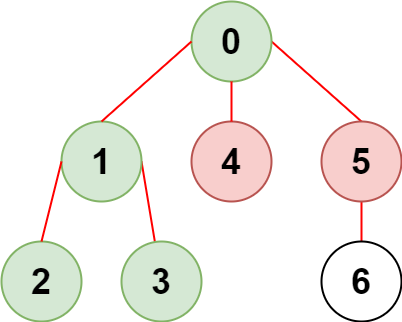Welcome to Subscribe On Youtube
Formatted question description: https://leetcode.ca/all/2368.html
2368. Reachable Nodes With Restrictions
- Difficulty: Medium.
- Related Topics: Array, Hash Table, Tree, Depth-First Search, Breadth-First Search, Graph.
- Similar Questions: Open the Lock, Minimum Jumps to Reach Home.
Problem
There is an undirected tree with n nodes labeled from 0 to n - 1 and n - 1 edges.
You are given a 2D integer array edges of length n - 1 where edges[i] = [ai, bi] indicates that there is an edge between nodes ai and bi in the tree. You are also given an integer array restricted which represents restricted nodes.
Return the **maximum number of nodes you can reach from node 0 without visiting a restricted node.**
Note that node 0 will not be a restricted node.
Example 1:

Input: n = 7, edges = [[0,1],[1,2],[3,1],[4,0],[0,5],[5,6]], restricted = [4,5]
Output: 4
Explanation: The diagram above shows the tree.
We have that [0,1,2,3] are the only nodes that can be reached from node 0 without visiting a restricted node.
Example 2:

Input: n = 7, edges = [[0,1],[0,2],[0,5],[0,4],[3,2],[6,5]], restricted = [4,2,1]
Output: 3
Explanation: The diagram above shows the tree.
We have that [0,5,6] are the only nodes that can be reached from node 0 without visiting a restricted node.
Constraints:
-
2 <= n <= 105 -
edges.length == n - 1 -
edges[i].length == 2 -
0 <= ai, bi < n -
ai != bi -
edgesrepresents a valid tree. -
1 <= restricted.length < n -
1 <= restricted[i] < n -
All the values of
restrictedare unique.
Solution (Java, C++, Python)
-
class Solution { public int reachableNodes(int n, int[][] edges, int[] restricted) { List<Integer>[] graph = new ArrayList[n]; for (int i = 0; i < n; i++) { graph[i] = new ArrayList<>(); } for (int[] edge : edges) { int src = edge[0]; int dest = edge[1]; graph[src].add(dest); graph[dest].add(src); } Queue<Integer> q = new ArrayDeque<>(); boolean[] visited = new boolean[n]; q.offer(0); visited[0] = true; for (int node : restricted) { visited[node] = true; } int ans = 0; while (!q.isEmpty()) { int vertex = q.poll(); ans++; for (int neighbour : graph[vertex]) { if (!visited[neighbour]) { q.offer(neighbour); visited[neighbour] = true; } } } return ans; } } ############ class Solution { private List<Integer>[] g; private boolean[] vis; private int ans; public int reachableNodes(int n, int[][] edges, int[] restricted) { g = new List[n]; Arrays.setAll(g, k -> new ArrayList<>()); vis = new boolean[n]; for (int v : restricted) { vis[v] = true; } for (int[] e : edges) { int a = e[0], b = e[1]; g[a].add(b); g[b].add(a); } ans = 0; dfs(0); return ans; } private void dfs(int u) { if (vis[u]) { return; } ++ans; vis[u] = true; for (int v : g[u]) { dfs(v); } } } -
class Solution: def reachableNodes( self, n: int, edges: List[List[int]], restricted: List[int] ) -> int: g = defaultdict(list) vis = [False] * n for v in restricted: vis[v] = True for a, b in edges: g[a].append(b) g[b].append(a) def dfs(u): nonlocal ans if vis[u]: return ans += 1 vis[u] = True for v in g[u]: dfs(v) ans = 0 dfs(0) return ans ############ # 2368. Reachable Nodes With Restrictions # https://leetcode.com/problems/reachable-nodes-with-restrictions/ class Solution: def reachableNodes(self, n: int, edges: List[List[int]], restricted: List[int]) -> int: graph = defaultdict(list) visited = [False] * n blocked = set(restricted) for x, y in edges: graph[x].append(y) graph[y].append(x) res = 0 def dfs(node): nonlocal res visited[node] = True res = 1 for nei in graph[node]: if nei not in blocked and not visited[nei]: res += dfs(nei) return res return dfs(0) -
class Solution { public: int ans; int reachableNodes(int n, vector<vector<int>>& edges, vector<int>& restricted) { vector<vector<int>> g(n); for (auto& e : edges) { int a = e[0], b = e[1]; g[a].push_back(b); g[b].push_back(a); } vector<bool> vis(n); for (int v : restricted) vis[v] = true; ans = 0; dfs(0, g, vis); return ans; } void dfs(int u, vector<vector<int>>& g, vector<bool>& vis) { if (vis[u]) return; vis[u] = true; ++ans; for (int v : g[u]) dfs(v, g, vis); } }; -
func reachableNodes(n int, edges [][]int, restricted []int) int { g := make([][]int, n) for _, e := range edges { a, b := e[0], e[1] g[a] = append(g[a], b) g[b] = append(g[b], a) } vis := make([]bool, n) for _, v := range restricted { vis[v] = true } ans := 0 var dfs func(u int) dfs = func(u int) { if vis[u] { return } vis[u] = true ans++ for _, v := range g[u] { dfs(v) } } dfs(0) return ans } -
function reachableNodes( n: number, edges: number[][], restricted: number[], ): number { let res = 0; const vis = new Array(n).fill(false); const map = new Map<number, number[]>(); for (const [start, end] of edges) { map.set(start, [...(map.get(start) ?? []), end]); map.set(end, [...(map.get(end) ?? []), start]); } const dfs = (cur: number) => { if (restricted.includes(cur) || vis[cur]) { return; } res++; vis[cur] = true; for (const item of map.get(cur) ?? []) { dfs(item); } }; dfs(0); return res; }
Explain:
nope.
Complexity:
- Time complexity : O(n).
- Space complexity : O(n).